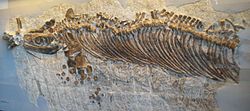- Cymbospondylus
-
Cymbospondylus
Temporal range: 240–210 Ma Between the Middle and Late TriassicC. buchseri fossil Scientific classification Kingdom: Animalia Phylum: Chordata Class: Sauropsida Subclass: Diapsida Superorder: Ichthyopterygia Order: Ichthyosauria Genus: Cymbospondylus Species - C. natans
- C. germanicus
- C. nevadanus
- C. parvus
- C. piscosus
- C. grandis
- C. petrinus
- C. buchseri
Cymbospondylus ( A Greek word meaning "Boat Spine") was a basal early ichthyosaur that lived between the middle and later years of the Triassic period (240-210 million years ago). Previously, the genus was classified as a shastasaurid, however, more recent work finds it to be more basal[1].
Contents
Discovery
Fossils have been found in both Germany and Nevada, and the first species was named by Joseph Leidy in 1868. It was not until the early 1900s that the first complete skeletons were discovered. Fossil vertebrae from Cymbospondylus were allegedly used as plates by Nevada's silver miners; it is now the state's official fossil.
Palaeobiology
Cymbospondylus was one of the largest ichthyosaurs, with fossils ranging from 6 to 10 metres (20 to 33 ft) long.[2] It was also one of the least fish-like of the ichthyosaurs, lacking a dorsal fin and fluked tail. It did, however, have an elongated snout like other ichthyosaurs.[3]
Despite its size, Cymbospondylus would not have been much of a threat to other marine reptiles, such as Nothosaurus. The one metre long head[2], with large jaws, contained rows of teeth which were so small that they could not have grasped and held on to large animals, let alone kill them. Instead, the teeth appear to have been adapted for catching and holding on to small and medium-sized fish, belemnites, and cephalopods such as ammonites. The long tail would have been excellent for swimming, and allowed Cymbospondylus to move at fast speeds and efficiently hunt down shoals of swimming fish.
Adult Cymbospondylus probably spent much of their time hunting in deep offshore water, only venturing into shallower water to breed or to catch seasonally available prey. Like other ichthyosaurs, Cymbospondylus probably gave birth to live young, as it had no way to lay eggs.[2] These, on reaching adult size, probably had few, if any, predators that could harm them.
The eel-like tail of Cymbospondylus made up almost half the total body length, and it is possible that the tail was used as a primary swimming mechanism. Like present day sea snakes, Cymbospondylus probably swam by wriggling its body from side to side. The paddle-like limbs of Cymbospondylus would primarily have been underwater stabilizers, and for slowing down the ichthyosaur's swimming speed.[3]
In popular culture
- Cymbospondylus was featured in the BBC documentary, Sea Monsters, as the top predator of the Triassic, and as the sixth most dangerous sea creature of all time.
- It also appeared in the BBC's The Complete Guide to Prehistoric Life, where it was erroneously dubbed "The largest ichthyosaur of all time". The title, in fact, belongs to Shastasaurus.
References
- ^ Motani, R. 1999: Phylogeny of the Ichthyopterygia. Journal Of Vertebrate Paleontology. 19 (3): 473 - 496
- ^ a b c "Cymbospondylus". BBC - Science & Nature. http://www.bbc.co.uk/science/seamonsters/factfiles/cymbospondylus.shtml. Retrieved 2009-05-25.
- ^ a b Palmer, D., ed (1999). The Marshall Illustrated Encyclopedia of Dinosaurs and Prehistoric Animals. London: Marshall Editions. p. 78. ISBN 1-84028-152-9.
- Haines, Tim and Paul Chambers. 2006: The Complete Guide to Prehistoric Life. Pg. 65. Richmond Hill, Firefly Books Ltd.
- Dixon, Dougal (2006). The Complete Book of Dinosaurs. Hermes House.
External links
Categories:- Triassic ichthyosaurs
- Prehistoric reptiles of Europe
- Prehistoric reptiles of North America
Wikimedia Foundation. 2010.



